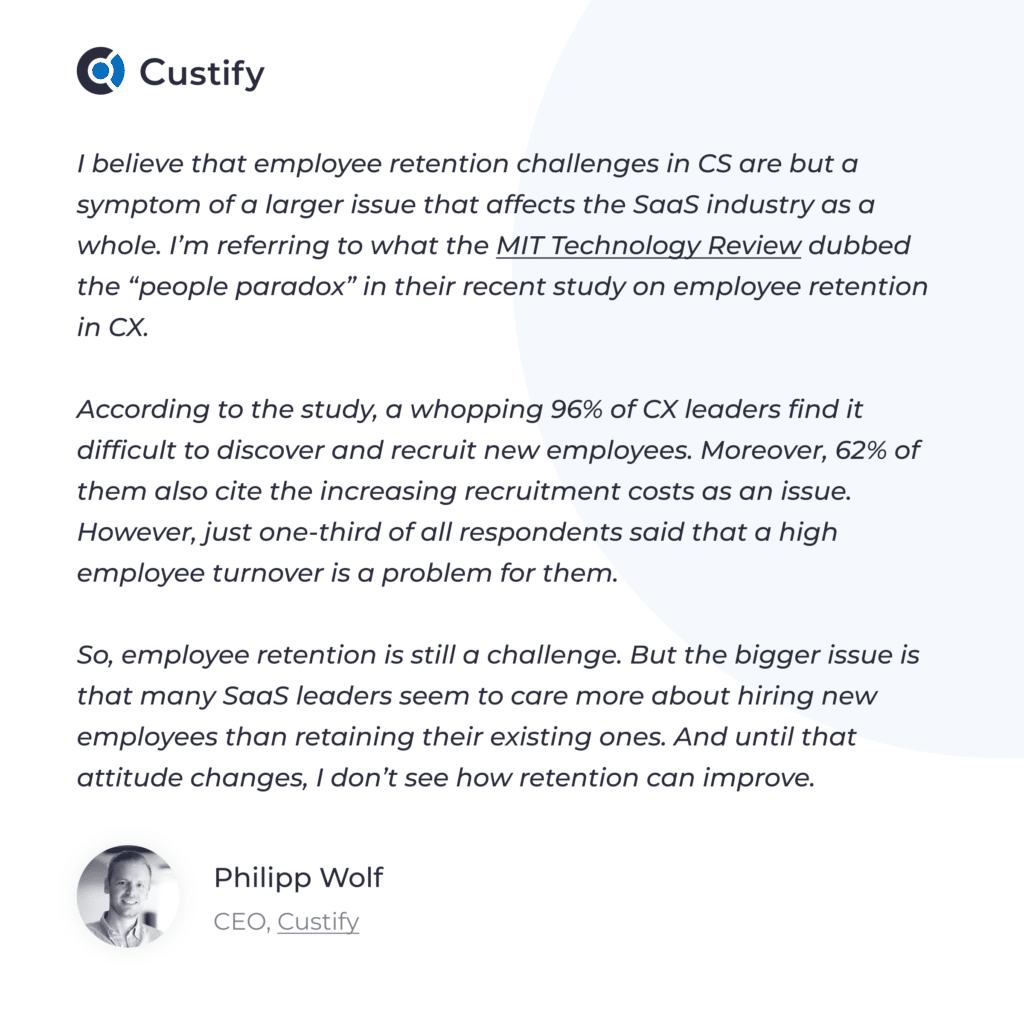When gathering data for our study on quiet quitting in customer success, we discovered a surprising phenomenon. In addition to quiet quitting, it seems like CS teams are struggling with physically retaining their employees almost as much.
More specifically, 71% of CS personnel we surveyed said that they had teammates physically quit in the past 12 months. What’s more worrisome is that nearly half of all those CSM who had quit were senior-level employees.

Source: Quiet Quitting Survey 2023
Based on this data, it seems that between quiet quitting and actual quitting, employee retention is currently a challenge in customer success.
But why is that? Here’s what the respondents of our survey had to say!
1. Lack of Opportunities for Professional Development
“To me, a lack of career growth opportunities is the main cause of employee retention challenges in CS, especially when it comes to senior employees.
Senior team members are frequently seeking new challenges and opportunities for professional development. If they believe they’ve reached a plateau in their current position, they may leave for a company that can give them more opportunities for advancement.
This issue can be solved by implementing a clear career progression plan for each team member and giving them opportunities to grow and evolve in their role.”
Sunny Kumar — Founder & Marketing Specialist, TheWPX
Senior professionals are just as eager to advance their careers as juniors, if not more. Just like Sunny said, giving them opportunities to do so is essential if you want them to remain committed to your organization.
2. Lack of Recognition
“It’s possible that people working in customer success don’t receive the same amount of recognition and awards as individuals working in other departments, like sales or product development.
Because their achievements can be difficult to quantify, CSMs may get the impression that their value to your company is not being recognized. As a result of this, they may feel like they are not respected like they should be. Ultimately, this may lead them to become disillusioned about the value they bring to your organization and seek validation elsewhere.”
Mark Lindquist — Head of Marketing, Community Phone
Mark makes a good point here. Because CS has long been seen as a back-of-house operation within many organizations, CSMs got used to the idea that their achievements are invisible to the rest of the company. However, as companies embrace employee milestone recognition, acknowledging the contributions of customer service teams can boost morale and highlight their role in driving growth.
Fortunately, that’s changing now that CS is starting to be regarded as a true growth driver that brings tangible value to an organization.
3. Poor Internal Processes
Toby Schulz, CEO at Alphabet Services, mentioned:

Your organization is only as strong as your processes, and Toby gets this absolutely right. When you have senior CSMs dealing with things that are beyond their responsibility, it both kills their morale and wastes your organization’s resources.
4. Poorly Fitting Roles for Senior Professionals
“One major factor contributing to job retention struggles in CS is a lack of employee engagement. CSMs aren’t feeling appreciated or valued by their employers if they don’t feel like their work is respected or valued. This lack of engagement can lead to decreased motivation, productivity, and ultimately higher attrition rates.
Another cause of high turnover rates amongst senior positions could be ill-fitting roles. When employers don’t fully understand an individual’s skills before hiring them and assign them duties that are beyond their capabilities, it can lead to frustrations developing between both sides. Eventually, this leads to employees seeking out alternatives that are a better fit for their skills.”
Richard Nolan — Chief People Officer, Epos Now
Richard touches upon a common sentiment here. The success and loyalty of your senior CSMs largely depends on how fulfilled and self-actualized they feel in their roles.
However, as he elaborates, that doesn’t only depend on how engaged you are with them. Their roles and responsibilities should also fit their skills and capabilities — challenging enough to learn and grow, but also not too simple or menial.
5. Too Much Pressure Leading to Burnouts
Jon Hill, CEO and Chairman at The Energists, stated:

There is no hiding from the fact that CS can be a very demanding industry. Plus, there is now more pressure on CSMs to drive business growth than ever before. Ultimately, if not relieved properly, all this pressure will lead to your CSMs simply burning out.
Fortunately, there are things we have already discussed that can help you make your CSM’s jobs easier, including automation and clearly defined internal processes.
And remember: CS is a marathon, not a sprint. Don’t push your CSMs too hard and let them prioritize the quality of customer relationships they build, not building them faster.
6. Toxic Company Culture
“If you’ve spent any time on LinkedIn, you’ve probably seen this mantra making rounds: employees don’t quit jobs — they quit toxic managers. Unfortunately, this sentiment couldn’t be more accurate, and customer success is no exception. I have heard many, many people say that they had quit jobs because they hated their immediate bosses.
As such, if you’re looking to retain your employees, you should take better care of them! Nothing helps foster true loyalty like a healthy company culture. Nipping toxic behavior in the bud and holding the perpetrators accountable is a win-win for your employees and your organization. By showing your employees that you are committed to them, you’ll inspire them to be committed to you.”
Irina Vatafu — Head of Customer Success, Custify
Irina has said it all — a toxic workplace culture will kill all your efforts at retaining your employees, and there’s no getting around that. Sadly, this issue is more common than it seems. And what’s worse, sometimes it doesn’t get taken seriously enough.
As a CS leader, you cannot afford to make that mistake. Toxic behavior within your organization should only get one level of tolerance — and that’s zero. Furthermore, It’s important to stay updated on the latest employee health and benefits trends to ensure a well-rounded workforce and foster a strong company culture.
7. Inadequate Compensation Levels
“Customer success team leads and other senior employees are stuck between a rock and a hard place as they are dealing with wages that aren’t keeping up with inflation and rising costs of living.
Naturally, it’s difficult for them to justify going above and beyond and demonstrating the proactive attitude that’s expected of them. This puts them in the position of having to do more with less, while also being the bad guys in the eyes of the understandably fed-up junior employees.
As a result, for many senior CSMs, it simply isn’t worth the hassle anymore. Fortunately, the solution is relatively straightforward — reward your CSMs for their hard work with fair wages!”
Nick Valentino — VP of Market Operations, Bellhop
Nick has a point: sometimes, the main challenge around employee retention can be as simple and prosaic as inadequate compensation.
Think about Maslow’s hierarchy of needs. Of course, your CSMs want to feel fulfilled and self-actualized in their roles. However, it would be difficult for them to achieve that you don’t meet their more basic need for adequate financial reward. This means not only providing fair wages but also ensuring absolute clarity and accuracy in every paycheck, which is where tools for generating professional paystubs become indispensable for maintaining employee trust and satisfaction.
With that said, there isn’t really more to add here other than: pay your CSMs fairly!
8. The People Paradox

Philipp hits the nail on the head here — the worst thing you can do as a CS leader is to simply accept the high employee turnover rate and do nothing about it. Of course, such a replace-not-repair attitude will do nothing but harm to your organization. Instead, you should take employee turnover seriously and do your best to retain your CSMs for the long game.
Conclusion
Between professional growth challenges, poorly defined roles, and a demanding work environment, it’s no longer a surprise that organizations struggle with retaining their CSMs.
The good news is that none of the issues outlined in this article are particularly inherent to the CS industry. That is, you are not doomed to eventually lose your entire CS team. Instead, these challenges are primarily managerial and can be resolved with effective leadership.




